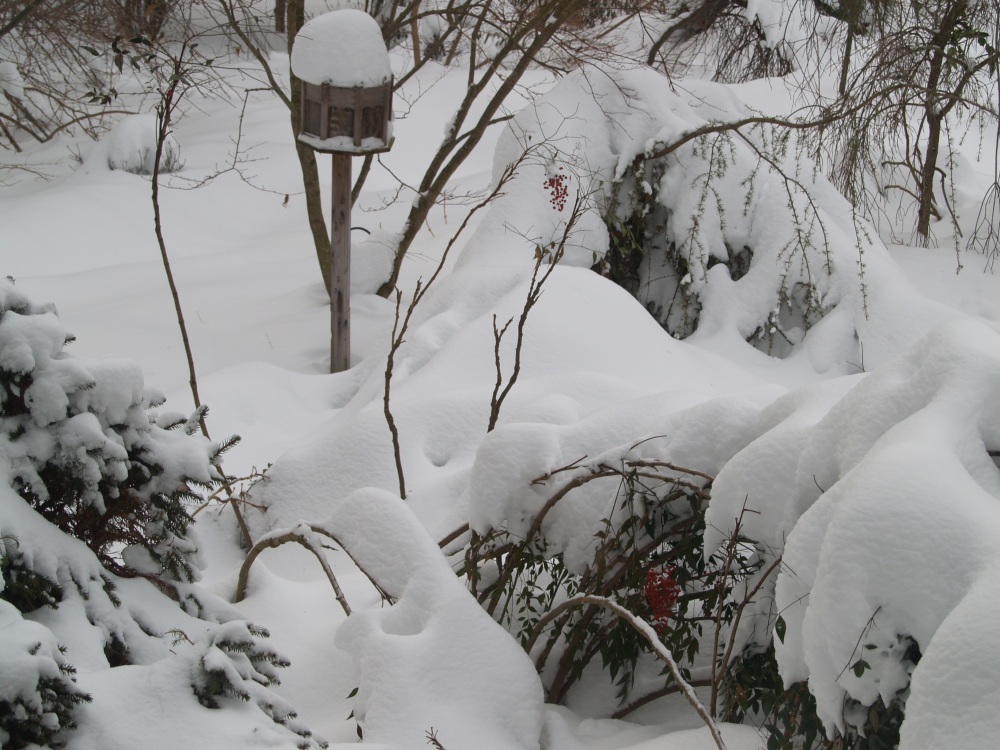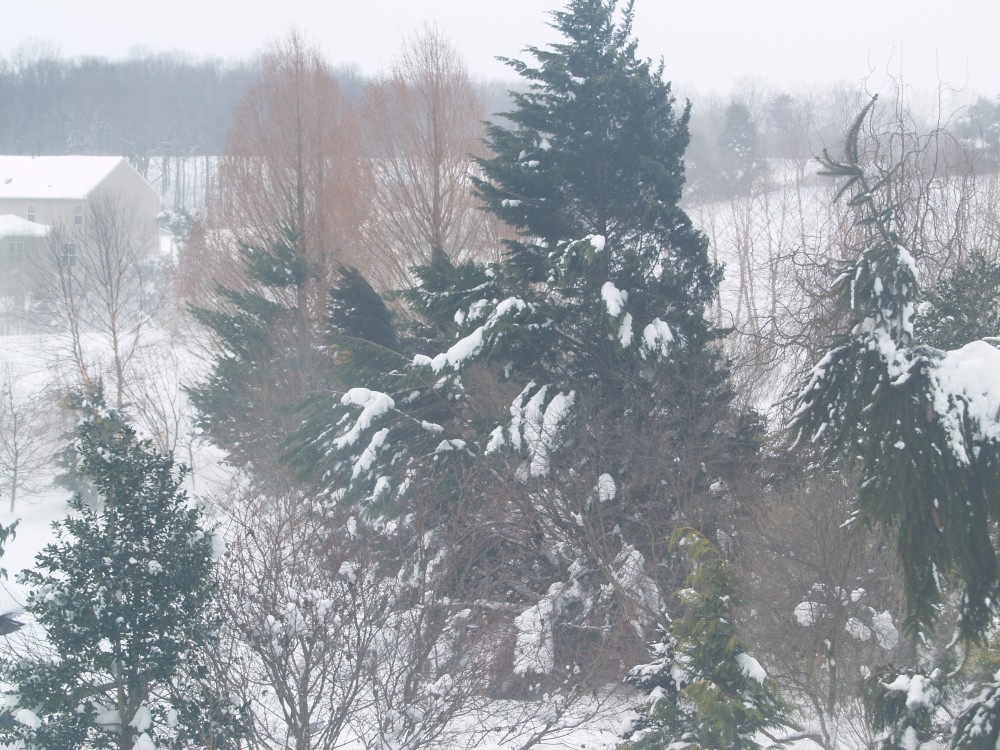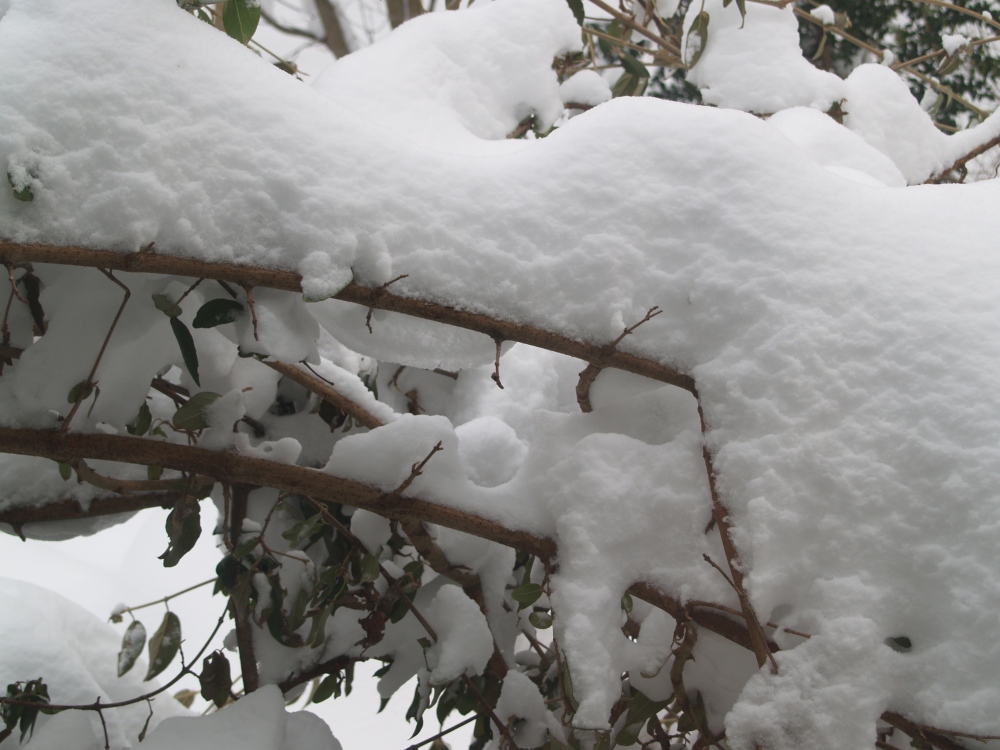My short driveway is an asphalt valley between two tall snowcapped peaks. Beneath the thick snowy blanket are roses, nandinas, liriope, hollies, camellias, a fernspray cypress that is growing too wide for its proximity to the drive, and an old weeping theadleaf Japanese maple that encroaches on the drive by several feet. No doubt there are problems under there, but damage from the weight of the snow won’t be evident until it melts, perhaps for weeks.

Following the heavy December snow there were a few broken branches on the large hollies, and a host of bent branches on the tall junipers and hollies. The nandinas were arched to the ground, but all have since nearly recovered their form, and damage from that storm will be fixed with a few snips of the pruners.
Though I haven’t traveled through the back garden since the latest blizzard, I see from a distance that a large branch of an evergreen cypress has split (which was a poorly developed crotch that I failed to repair when the tree was younger, so I’ve gotten my just desserts). I expect a few more problems than from the earlier snow, but not enough to be bothered about, and none that compares to the damage I’ve seen in the neighborhood, and heard of from acquaintances.

Trees ripped from the ground, roots and all
When I hear about a large evergreen that has blown over, exposing the roots, I know that we’re talking about only one plant, Leyland cypress. They have weak root systems, and in sandy soils that don’t allow a strong foothold like the clay soils predominant in this area, Leylands blow over with regularity. With hundreds, perhaps thousands of pounds of snow clinging to the branches, and a bit of breeze, they will fall in an instant.
Is there a chance the tree can be saved? Don’t bet the farm on it. First, the roots are exposed, freezing and drying out. It’s likely they’ll be dead or badly injured before the tree can be righted. Second, roots have been torn, mangled, and broken in the process of being pulled from the ground, not a good thing for any plant, but particularly not for a finicky tree that often resents transplanting. Third, how do you dig a hole, pull the monster upright, backfill soil without leaving huge air pockets that will fill with water and probably kill it if all else doesn’t, and then support it so it doesn’t blow over in the next puff of a breeze?
You don’t, so save your money and effort to plant a tree to replace it.
One half of the split trunk of my large American holly snapped off
Well of course it did. It was bound to happen, sooner or later. Weak crotches of evergreens and deciduous trees will fail eventually, though, of course, deciduous trees are rarely a threat to split under duress from snow. It should be plain to see that we can’t reattach the severed limb, so cut it up and dispose of it, and we’ll see if the remainder of the tree has enough fullness to save.
What to do with the splinters left behind? Wait for nicer weather, then make a clean cut, trying to leave an inch or so of the trunk so that the cut might heal. All of this is probably much ado over nothing, as the tree will probably be so unsightly without its missing half that the cut will be made to remove the remainder and be done with it.
The top half of an evergreen tree has snapped off
The first issue is that the trunk or branches are probably still attached to the tree. If they don’t pose a safety hazard there is no reason that this project can’t wait a few weeks. The damage is done and there’s no benefit to you or the tree in attempting repairs in nasty weather. If the damaged branch blocks a driveway, or is in danger of falling onto the house you might have to take care of it sooner. In many cases this is a task for a professional with the proper climbing and safety equipment.
There’s probably not much that can be done to save the ornamental value of this tree in the short term. Many evergreens will grow a replacement leader (main trunk), but it can take years before the natural form is regained. With some large evergreens, particularly pines that are most vulnerable to injury, it might be impossible, and the only realistic solution will be to remove the entire tree. So, the answer is, the trees are unlikely to die from the injury, but each will need to be evaluated for their ornamental value.

The _________ (supply the plant of your choice) has been squashed
This one is more hopeful. The snow will melt, and most branches, even those you’re figuring have been crushed, will spring back after a couple weeks and look nearly as good as ever. If they don’t bounce all the way back you can help persuade them by pruning some off the top, and with a lighter load the branches are more likely to spring back into shape.
For now, exercise some patience, sit back and wait for the snow to melt, then take a tour of the garden on a warm, sunny day to assess the damage. Take along your pruners. There will be a bunch of small broken branches, and some larger limbs that can be pruned easily.
Is there anything good that comes of this much snow?
Of course, there’s always a bright side. Plants most often die in the winter months from a lack of available moisture and drying winds. You don’t need me to tell you there’s plenty of moisture, and the snow’s so high that plants are buried and not exposed to the wind. Also, roots are protected from subfreezing temperatures by a snowy blanket of insulation. Your plants are better off than you suspect.
Hi Dave,
I just wanted to say your gardens and ponds are gorgeous. I have been concerned about my nandinas, they are fully grown and my husband cleared the roof of heavy snow and when it fell it broke quite a few branches of 3-4 of them. They are quite unsitely now and I need to know if I should cut them down low or just shape them up. I have one that may need to be replaced. My landscaping was done by Meadows Farms and I know they are not guaranteed due to the wrath of Mother Nature. They are located in the front of my house so they are very visual. I would appreciate any feedback. I know I need to wait at least 3-4 weeks to prune them. Thank you for your help.
Nandinas have taken quite a hit from the heavy snow this winter, but will be one of the plants least effected once the snow has melted. They will spring back upright, and after another month there will be little evidence of injury.
However, your issue is a little different. Broken branches can be pruned to just about any height on the stem, and new growth will pop out. I would try to prune only the broken stems, and not the entire top of the plant, unless there are so few longer stems remaining that the plant looks awkward, then you can prune them all.
We just had a heavy and wet snowfall in Westchester County, NY and the tops of 2 of my evergreens are bent 45 degrees. Will they bounce back or do they need support? Should I prune the weight off so the branch can snap back to its original position? Do I prune now or in the spring. The only danger is to the tree itself.
I also had 2 evergreens that have been snapped in half and the front half of the trunk is exposed, no bark. Should I prune just below the exposed area immediately, later or not at all. The wounded areas are unsightly to the eye.
First, for the evergreens that have tops that have bent, I would recommend waiting until we have some warm weather before making any decisions. I believe that most of the bent branches will straighten, at least partially. Many will straighten completely, and more drastic action might not be needed. In any case, there is no rush.
If the trees have not straightened by mid Spring then it will be appropriate to take the next step, and what that is will depend on the type of tree. Some trees, such as pines, do not have growth buds between branches, so if they are pruned mid way the branch will die back to the lower branch, while many spruce and other evergreens will grow from the point where the branch was pruned.
The two evergreens that snapped in half will need to be cut down to the next lower branch. In some cases this will disfigure the tree to the point that you might decide that it has lost its ornamental appeal and the entire tree must be removed. This will be happen to many trees damaged by the snow in the Washington DC area.